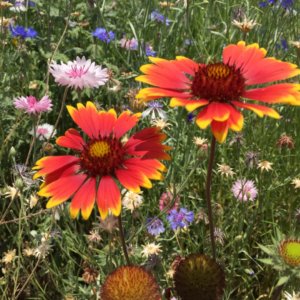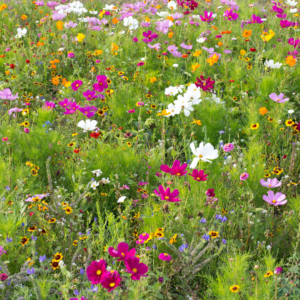


The most appealing thing about wildflowers is their combination of beauty and self-sufficiency. They offer a dazzling range of color and form while displaying hardiness and adaptability not usually found in their more domesticated cousins, the garden flowers. Wildflowers actually prefer soils of low fertility, and many species are drought tolerant. These qualities make them ideal for landscaping where a low-maintenance approach is desired. Parks, industrial buildings, roadsides, country clubs, “roughs” in-between golf course greens, landfills, revegetation projects. While a natural display of wildflowers in a meadow may look to be a casual phenomenon, natural forces may have taken years to achieve such effects. The following guidelines for planting wildflowers should be followed for maximum success.
Choosing Wildflowers To Plant
Climatic regions have been established for North America based on the similarity of temperature, rainfall, and elevation. Within each region than can exist considerable variation, especially from year to year. Under such conditions, it is usually best to plant a mixture of wildflower species that are suitable for the range of conditions, plant height, color, flowering period, aggressiveness and ability to reseed. This will ensure long lasting color throughout the season for years to come. We have created several mixtures that have a precise balance of annuals and perennials that will provide a succession of flowers from spring to late summer. For special requirements, custom mixes can be blended on the basis of plant height, flower color, climatic conditions, drought tolerance or other criteria.
Identify The Correct Planting Time
If planting depends entirely upon rainfall for germination and growth, you must plant in anticipation of the rainy season. For many climates, this means a mid-March or April planting. Where supplemental water is available, wildflowers can be planted during the summer. A late summer planting can be done no later than 8-10 weeks before the first frost. In northern climates, a late-fall planting can be done to allow overwintering for spring germination.
Prepare Your Site For Seeding
Soil preparation is a key step because seed to soil contact is vital for seed germination and healthy rooting of seedlings. Rake, till or plow the site to loosen the top 3 to 4 inches (4 to 6 inches is ideal) of soil.
Removing existing weeds and mowing or cutting down of vegetation is recommended for sites small and large.
Wildflowers prefer soils of low fertility. High nitrogen soils only encourage the growth of weeds and lush vegetation growth at the expense of flowers. However, if your site soil is completely without nutrients consider using a low nitrogen fertilizer like our Biosol Forte 7-2-1. The final seedbed should be smooth, free of large clumps and firm.
Planting Methods for Wildflower seeds
There are many effective installation techniques, and the size of site will probably determine which makes the most sense for you. The two methods that are probably most advisable are 1. the old-fashioned hand-broadcast method (for smaller jobs), and 2. the use of a rotary or “cyclone” seeder (for larger jobs). The former involves simply scattering the seed evenly over the site by hand, while the latter accomplishes the same results through the use a hand-cranked spreader that can be purchased relatively cheaply at any garden center. If seeding an area of several acres or more, hydro-seeding is our recommended method.
Regardless of which sowing method you choose; we strongly recommend mixing your seed with regular sand or vermiculite at a ratio of about 5 parts (sand/vermiculite) to 1 part (seed). This allows for a more even distribution and also provides a convenient way to mark which portions of the site have been seeded and which have not. This is not a required method for a successful planting, but most will find it a simple, affordable, and practical step.
After sowing, we recommend that you lightly compress your seeds into the soil – no more than a ½ inch – so as to protect them from birds, wind disbursement, etc. The key here is to compress them, but not bury them. If the site is of a manageable size, you can accomplish this by simply walking over the portion that’s just been seeded, or if it’s a larger area, you might want to use a standard seed roller; often used when planting grass seed.
Post-Planting Care
You are almost done! The planting area must be kept moist for 4-6 weeks using supplemental water if necessary, in order to ensure germination of as many wildflower species as possible. As the planting becomes established, water can be gradually reduced. Many wildflowers are drought tolerant once they are established. In dry climates or drought conditions, supplemental irrigation once a week will lengthen the blooming period of the wildflower display. Mow the area in the fall to 4-6 inches after most of the flowers are finished blooming and set seed. Mowing will help scatter seeds for next year’s blooming. Next spring consider supplementing the site with some new seed in order to more firmly establish the permanence of the planted area and suppress weed growth.




